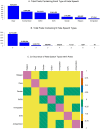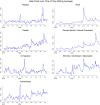Offline events and online hate
- PMID: 36696388
- PMCID: PMC9876356
- DOI: 10.1371/journal.pone.0278511
Offline events and online hate
Abstract
Online hate speech is a critical and worsening problem, with extremists using social media platforms to radicalize recruits and coordinate offline violent events. While much progress has been made in analyzing online hate speech, no study to date has classified multiple types of hate speech across both mainstream and fringe platforms. We conduct a supervised machine learning analysis of 7 types of online hate speech on 6 interconnected online platforms. We find that offline trigger events, such as protests and elections, are often followed by increases in types of online hate speech that bear seemingly little connection to the underlying event. This occurs on both mainstream and fringe platforms, despite moderation efforts, raising new research questions about the relationship between offline events and online speech, as well as implications for online content moderation.
Copyright: © 2023 Lupu et al. This is an open access article distributed under the terms of the Creative Commons Attribution License, which permits unrestricted use, distribution, and reproduction in any medium, provided the original author and source are credited.
Conflict of interest statement
The authors have declared that no competing interests exist.
Figures





References
-
- Oksanen A., Hawdon J., Holkeri E., Näsi M., & Räsänen P. (2014). Exposure to online hate among young social media users. In Soul of society: a focus on the lives of children & youth. Emerald Group Publishing Limited.
-
- Siegel, A., Tucker, J., Nagler, J., & Bonneau, R. (2018). Socially mediated sectarianism. Unpublished manuscript. https://alexandra-siegel.com/wp-content/uploads/2019/05/Siegel_Sectarian...
-
- Müller, K., & Schwarz, C. (2020). From hashtag to hate crime: Twitter and anti-minority sentiment. SSRN 3149103.
-
- Williams M. L., Burnap P., Javed A., Liu H., & Ozalp S. (2020). Hate in the machine: Anti-Black and anti-Muslim social media posts as predictors of offline racially and religiously aggravated crime. The British Journal of Criminology, 60(1), 93–117.
Publication types
MeSH terms
LinkOut - more resources
Full Text Sources

